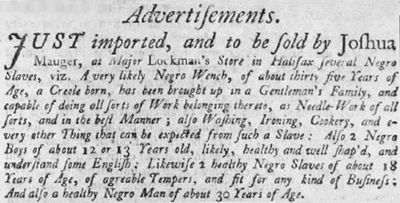|
“Speak to me. Tell me everything. Do not forget.” - Biton, Chief of Sama, Book of Negroes by Lawrence Hill I am thrilled about the release of the Book of Negroes six-part mini-series. I waited in eager anticipation for this month when it would finally be aired. Why you ask? As an historian and curriculum consultant who specializes in African Canadian history, I am very aware that there are not enough opportunities to see on-screen depictions of the experiences of Black colonists in Canada. This is a much-welcomed rare occasion. I was thoroughly captivated by the novel. Three Christmases ago, I stayed up late into the wee hours of the morning to read the book, the illustrated edition signed by Lawrence Hill, over the course of four days. It was such riveting storytelling and I could not put that book down. I was further enthused when I was asked a couple of months ago to lend my consulting expertise to revise Historica’s Black History Education Guide 2015, a teaching resource for the Book of Negroes novel, to include the widely anticipated mini-series. Another reason for my deep interest in seeing the novel come to the screen is that for a segment of the story, this moving narrative centres the Black female Loyalist voice within the realm of Canadian history, a space where the Black Canadian experience continues to be excluded or marginalized. Aminata’s story and the experiences of Black United Empire Loyalists can be taught through grades 6 to 12 using a wide range of available online and book resources. NEW! The CBC Teacher Resource Guide for the Book of Negroes miniseries is now available! I was thrilled to develop the elementary level portion of the guide. Videos of the Book of Negroes miniseries are available on the CBC website http://www.cbc.ca/bookofnegroes/. Preview all videos before showing in class. For middle school grades, select appropriate segments. The last stop of enslaved Africans before their forced removal from the continent was one of the coastal European slave forts, where they were held in pens. A Virtual Tour of Goree Island provides some insight into the final moments before departure to the Middle Passage. Freedom Child of the Sea by Richardo Keens-Douglas is a picture book that touches on what could have happened to Sanu (the pregnant woman on the slave ship) before Aminata offers to “catch” her baby. This picture book is about spirits of a pregnant enslaved woman and her unborn child, who were thrown overboard a slave ship rescuing a drowning boy. At the time when the Black Loyalists arrived in Canada, they would have encountered enslaved Blacks. There was an active trade in African bodies in Canada. Blacks were bought and sold at auctions, through newspaper ads, and were bequeathed in wills. Approximately the same amount of enslaved Blacks as there were free Black Loyalists were brought in to Canada by white Loyalists entering Canada. Documents related to the enslavement of Africans in Canada are very useful for providing deeper context into Black life in Canada after the American Revolution. Check under “Primary/ Secondary Source Documents” from the Resources chiclet on my website. The actual Books of Negroes, the historical 150-page military ledger, is accessible online. The Nova Scotia Archives digitized the Book of Negroes artefact and made it searchable: http://novascotia.ca/archives/virtual/africanns/BN.asp. This can be used in conjunction with the transcription of the Book of Negroes to allow for an easier read for students: http://blackloyalist.com/cdc/index.htm (see ‘Documents’) Lord Dunmore's Proclamation (1775), which offered freedom to enslaved Blacks who supported the British cause, is available online in original form and transcribed. CBC has created an app called The Book of Negroes Historical Guide. Black Loyalists also settled in New Brunswick. Here are documents and lesson plans for examining the live of Black Loyalists in New Brunswick. Loyalist historian and researcher Stephen has written many copyrighted articles on Black Loyalists. Here is an index of his articles that were published in Loyalist Trails. They are very useful reference materials that provide a bit more insight into the lives of some of the men and women recorded in the Book of Negroes.
Many Black Loyalists remained in the United States. The Book of Negroes, Africans in America Part 2 and Black Loyalists, Africans in America Part 2 by PBS are great resources.
Black Loyalists also entered Canada through the Niagara region, including Richard Pierpoint and several other Black Loyalists. The Richard Pierpoint Heritage Minute and the Learning Tool and the Supplemental Activities, which I helped to develop, can be used to teach the perspective of these early settlers. We Stand on Guard for Thee: Teaching and Learning the African Canadian Experience in the War of 1812 uses augmented reality, or digital 3D storytelling to bring a select number of Black Loyalist narratives to life. I developed the lesson plans to support these stories. These are good resources to explore Black Loyalists in southwestern Ontario. My July 2014 Blog "We Would Die for Freedom: Integrating the African Canadian Narrative in the Teaching of the War of 1812," discusses additional resources for teaching about Black Loyalists. Documents Related to Black Loyalists in Canada Here, Black Loyalists, 1783-1792, the Nova Scotia Archives has a range of related primary documents available including passports, petitions, manumission papers, runaway ads, and muster rolls. Books The Black Loyalists: The Search for a Promised Land in Nova Scotia and Sierra Leone, 1783-1870 by James W. St. G. Walker is the book that influenced Lawrence Hill’s interest on this topic. Black Loyalists: Southern Settlers of Nova Scotia's First Free Black Communities by Ruth Holmes Whitehead. Birchtown and the Black Loyalists by author Wanda Taylor. The Canadian publisher of the Book of Negroes developed a teacher’s guide for studying the novel in grade 11 and 12 classrooms. http://lawrencehill.com/BON-Teachers-Guide.pdf The range of lessons on Black Loyalists that can be taught in classrooms must also include lessons that teach students to be critical of how African Canadians have been forcefully removed/ denied space on the Canadian landscape, marginalized or excluded from the Canadian narrative. African Canadians have been physically removed as in the instances of the Shelbourne Riots, the immigration ban in 1911, and the demolition of Africville (many residents of Africville were descendants of Black Loyalists listed in the Book of Negroes). Uncomfortable but necessary conversations need to be had about the persistence of historically racist perceptions as well as the legacy and implications of historical exclusion today. There is also an ethical judgment dimension of the mistreatment of African Canadians that is raised – 206 years of enslavement and a history of racial discrimination and segregation that is not readily acknowledged or widely taught. Making connections to the recently launched UN Decade for People of African Descent (January 2015 – December 2024) can get students to explore how they can contribute to addressing issues of racism and human rights in Canada. In the novel, Chief Biton’s words, “Speak to me. Tell me everything. Do not forget," resonated with me. His words were adapted for the TV screen in episode one in the powerful scene on the slave ship when the men held in shackles called out their names, beckoning the young Aminata to repeat their African names and where they were stolen from. The mini-series offers the space and opportunity to speak about Black Loyalists in Canada, to speak to the harsh realities of enslavement and anti-Black racism in Canada. By engaging this topic in the classroom, students are encouraged to remember - remember the lives, the hardships, the perseverance, and the contributions of Black Loyalist men and women; and remember their names.
11 Comments
Kris
1/22/2015 05:42:53 am
Do you think the actual novel Book of Negroes is age-appropriate reading for students in Grade 6? Or what age would you recommend.
Reply
1/23/2015 04:14:54 am
For the most part the novel is age-appropriate, giving consideration to some of the violent and sensitive scenes. I think that the best way to use it in grade 6 is to provide a summary of the novel, give some context (maybe with some pre-reading activities on African societies before European contact and the Transatlantic Slave Trade), and select a section to read with and to the class. Given the curriculum connections, using the chapter where Aminata arrives in Nova Scotia would be most suitable. Using the entire novel in a classroom would be more appropriate for a high school class.
Reply
Wanda Taylor
3/21/2016 11:00:43 am
Birchtown and the Black Loyalists by Wanda Lauren Taylor is an age appropriate book being used in classrooms to teach this history to a younger audience. I wrote it to ensure this history was not lost on forthcoming generations. It is available in all book stores and public libraries.
Wanda Taylor
3/21/2016 10:57:07 am
My book, published in 2014 specifically breaks the Blavk Loyslist story down for young readers using age appropriate themes, language, and photographs. It is being used in classrooms up to age 13. Birchtown and the Black Loyslists, by Wanda Lauren Taylor is available in all bookstores and public libraries. Make your child's school aware.
Reply
Yvonne Brown
1/22/2015 01:34:44 pm
Congratulations Natasha! Great curriculum resources that are timely in extending the learning opportunities that the Book of Negroes is enabling. It is indeed a celebratory moment: Canadian writer and diirector, CBC and TD!!! Please continue the pathbreaking work you have been doing. Yvonne
Reply
Wanda Lauren Taylor
4/10/2015 08:08:32 am
This was a great guide Natasha! Of note, my book, 'Birchtown and the Black Loyalists' is specifically geared towards school aged because the majority of the books on this topic are geared towards an adult audience. The vivid illustrations were purposely included to also cater to visual learners, and aid in the understanding for reluctant or slower learners. It was a project three years in the making, taking great care to handle the gruesome nature of our history with care and respect, while at the same time, not watering down what our ancestors suffered through. The hope of the book is that young people will come away with a renewed sense of pride and purpose after being inspired by the strength and resiliency of the ones who came before them. Thank you for including 'Birchtown and the Black Loyalists' in your mentions!
Reply
Erich
2/8/2021 12:31:02 pm
Thank you, this is a great resource and much needed as there is not much directed to elementary school aged children.
Reply
I, too, loved this novel, and could not put it down when I read it a few hours ago!!!
Reply
nadine
4/4/2016 09:28:04 pm
Would this be okay for my 14 year old? 8th grader.
Reply
Natasha
4/6/2016 11:56:22 am
Hi Nadine. You should determine that. I think that if your 14 year old watches mainstream movies then the series is fine for them to watch. You could preview the episodes to gauge how you feel about the content.
Reply
4/11/2017 12:26:57 am
I look for such article along time,today i find it finally.this post give me lots of advise it is very useful for me .i will pay more attention to you ,i hope you can go on posting more such post, i will support you all the time.
Reply
Your comment will be posted after it is approved.
Leave a Reply. |
AuthorNatasha Henry Archives
October 2023
Categories
All
|
||||||


